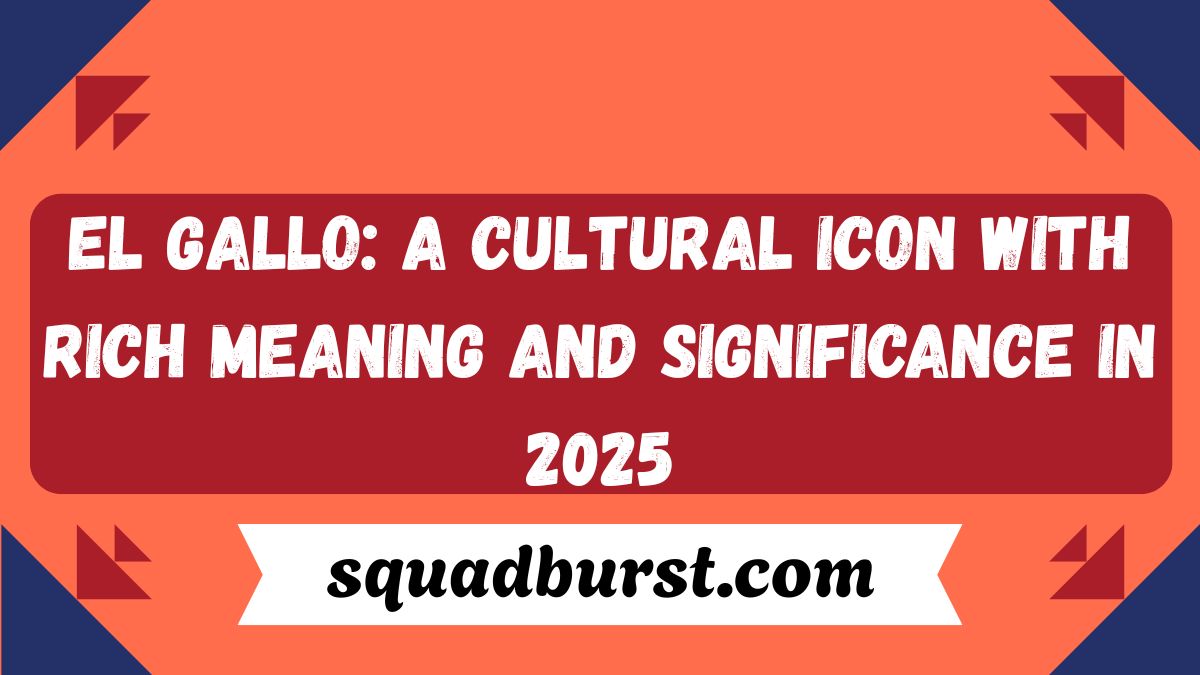El Gallo: A Cultural Icon with Rich Meaning and Significance in 2025 El Gallo transcends its literal translation as “the rooster” to embody one of Latin America’s most powerful cultural icons. This magnificent bird represents strength and courage, dawn and new beginnings, and masculine pride across centuries of tradition. From ancient mythology to modern celebrations, El Gallo weaves through music, literature, cuisine, and spiritual practices, maintaining its position as a symbol of resilience and protection that resonates with millions worldwide.
El Gallo: A Cultural Icon with Rich Meaning and Significance in 2025 Picture Vicente Fernández’s passionate voice belting out “El Gallo de Oro” while families gather around steaming bowls of Gallo en Mole. El Gallo: A Cultural Icon with Rich Meaning and Significance in 2025 Imagine masked wrestlers in Lucha Libre adopting rooster personas, their colorful costumes reflecting the bird’s fierce combativeness. This isn’t just folklore – it’s living culture that pulses through every mariachi song and festival celebration.
El Gallo: A Cultural Icon with Rich Meaning and Significance in 2025 Rooster symbolism extends far beyond barnyard origins, connecting ancient Catholic iconography with modern Mexican traditions. El Gallo: A Cultural Icon with Rich Meaning and Significance in 2025 Whether appearing in Spanish proverbs about vigilance or inspiring spiritual awakening at dawn, El Gallo bridges past and present.El Gallo: A Cultural Icon with Rich Meaning and Significance in 2025 This remarkable symbol continues evolving in 2025, adapting to contemporary contexts while preserving its core message of courage, renewal, and unwavering cultural identity.
Literal Meaning of “El Gallo”
What Does “El Gallo” Mean?
El Gallo literally translates to “the rooster” in English. However, this simple translation barely scratches the surface of its cultural depth. The word “gallo” stems from the Latin “gallus,” which ancient Romans used to describe these proud birds.
In Spanish culture and throughout Latin America, El Gallo represents far more than its barnyard origins suggest. The term carries connotations of leadership, vigilance, and protection. When someone calls you “un gallo,” they’re acknowledging your fighting spirit and determination.
The rooster symbolism extends beyond gender associations. While traditionally linked to masculine qualities, El Gallo embodies universal traits like resilience, punctuality, and reliability. These birds don’t need alarm clocks – they herald each dawn with unwavering consistency.
Spanish proverbs frequently feature roosters, highlighting their cultural importance. “Al gallo que no canta, algo le pasa en la garganta” translates to “If the rooster doesn’t sing, something’s wrong with his throat.” This saying emphasizes authenticity and staying true to one’s nature.
Symbolism and Cultural Significance of El Gallo

The Rooster as a Symbol of Strength and Courage
Rooster symbolism in Latin culture runs deeper than most people realize. These birds display remarkable courage when defending their territory or protecting their flock. This natural behavior transformed El Gallo into a metaphor for bravery and heroism across multiple cultures.
Mexican folklore celebrates roosters as fierce protectors. Traditional stories tell of roosters that saved entire villages from danger, using their loud crows to alert residents of approaching threats. These tales reinforce the rooster’s association with vigilance and discipline.
The physical characteristics of roosters contribute to their symbolic power. bright red combs represent vitality and life force. Their sharp spurs symbolize readiness for battle. Their proud stance embodies confidence and dignity.
Strength and courage manifest differently across cultures, but El Gallo consistently represents these virtues. In Mexican culture, calling someone “muy gallo” means they possess fighting spirit and won’t back down from challenges.
“El Gallo” in Folklore and Proverbs
Mexican proverbs featuring roosters offer wisdom accumulated over generations. “Gallo que no canta, algo le pasa” warns that silence might indicate problems. Another saying, “En casa de herrero, cuchillo de palo, pero el gallo siempre canta,” suggests that even in difficult circumstances, authentic voices persist.
Spanish culture embraces similar rooster wisdom. “A cada gallo le llega su San Martín” translates roughly to “every rooster meets his match eventually.” This proverb teaches humility and reminds us that nobody remains invincible forever.
Traditional folk tales across Latin America feature clever roosters outsmarting larger predators. These stories teach children about using intelligence over brute force. The rooster becomes a symbol of survival through wit and determination.
Rooster folklore often connects to agricultural traditions. Farmers relied on roosters not just for timekeeping, but as protectors of their flocks. This practical role elevated roosters to almost mystical status in rural communities.
The Awakening of New Beginnings
Dawn and new beginnings form the cornerstone of rooster symbolism worldwide. El Gallo‘s morning crow doesn’t just announce daybreak – it symbolizes renewal and opportunity. This association makes roosters powerful symbols of transformation and fresh starts.
Spiritual awakening connects deeply with rooster imagery. The bird’s ability to sense approaching dawn represents intuitive awareness and spiritual sensitivity. Many cultures view the rooster as a bridge between earthly and divine realms.
New Year celebrations across Latin America often feature rooster imagery. People believe that hearing a rooster’s crow at midnight brings good fortune for the coming year. This tradition links El Gallo with hope and positive change.
Timekeeping abilities of roosters impressed ancient civilizations. Before mechanical clocks, people depended on roosters for morning wake-up calls. This reliability earned them respect as symbols of punctuality and discipline.
“El Gallo” in Popular Culture

Music and Songs: The Rooster in Latin Music
Mexican music wouldn’t be complete without celebrating El Gallo. Vicente Fernández, the legendary “King of Ranchera,” immortalized roosters in multiple songs. His passionate performances transformed rooster metaphors into declarations of masculine pride and emotional strength.
“El Gallo de Oro” stands as perhaps the most famous rooster song in Mexican music. This classic tells the story of a fighting rooster that becomes a symbol of triumph against overwhelming odds. The song’s lyrics weave together themes of courage, perseverance, and honor.
Regional Mexican genres frequently incorporate rooster imagery. Mariachi bands perform countless songs featuring roosters as symbols of Mexican identity and cultural pride. These musical tributes help preserve rooster symbolism for new generations.
Vicente Fernández rooster songs demonstrate how El Gallo represents more than just barnyard animals. In “Como un Gallo,” Fernández compares himself to a proud rooster defending his territory – a powerful metaphor for protecting love and family.
Contemporary Latin artists continue this tradition. Modern reggaeton and pop songs sometimes reference roosters when discussing themes of masculinity, competition, or pride. This evolution shows how rooster symbolism adapts to changing cultural contexts.
“El Gallo” in Literature and Cinema
Mexican literature embraces rooster symbolism across multiple genres. Authors use El Gallo to represent everything from political resistance to personal transformation. Juan Rulfo’s works occasionally feature roosters as symbols of rural Mexican life and its inherent struggles.
Mexican cinema during its Golden Age frequently showcased roosters in both literal and metaphorical contexts. Films like “El Gallo de Oro” explored themes of ambition, success, and downfall through rooster fighting narratives.
Modern Latin American literature continues exploring rooster symbolism. Contemporary authors use El Gallo to examine issues of identity, tradition, and cultural change. These literary representations keep rooster symbolism relevant in modern discourse.
Magical realism, a prominent Latin American literary movement, often incorporates roosters as symbols bridging reality and fantasy. Authors like Gabriel García Márquez occasionally feature roosters in scenes that blur the lines between ordinary life and mythical elements.
“El Gallo” in Mexican Cuisine

Rooster Dishes in Mexico
Mexican cuisine celebrates roosters through numerous traditional dishes. Gallo en Mole represents perhaps the most sophisticated preparation, combining tender rooster meat with rich, complex mole sauce. This dish appears at important celebrations and family gatherings.
Caldo de Gallo provides comfort food that nourishes both body and soul. This hearty soup features rooster meat simmered with vegetables and spices. Mexican families often prepare this dish during cold weather or when someone needs healing.
Pozole de Gallo transforms the humble rooster into festive cuisine. This traditional stew combines rooster meat with hominy and chili peppers. The dish holds special significance during Mexican holidays and celebrations.
Traditional cooking methods for rooster require patience and skill. Older roosters need slow cooking to become tender. Mexican cooks developed numerous techniques for transforming tough rooster meat into delicious meals.
Mexican rooster dishes often carry cultural significance beyond nutrition. Preparing rooster meals connects families to their ancestral heritage and agricultural roots. These dishes represent continuity between past and present.
Festivals and Rooster Feasts
Rooster festivals occur throughout Mexico, celebrating both the bird and its cultural importance. Día del Gallo celebrations feature rooster-themed foods, music, and competitions. These events strengthen community bonds while honoring tradition.
Festive celebrations incorporating roosters often coincide with harvest seasons. Communities gather to share rooster meals and celebrate agricultural abundance. These gatherings reinforce the rooster’s connection to prosperity and good fortune.
Religious festivals sometimes feature rooster symbolism. Catholic communities might prepare rooster dishes for patron saint celebrations, connecting culinary traditions with spiritual observance.
Family unity emerges as a central theme in rooster feast traditions. Extended families gather to share elaborate meals featuring multiple rooster preparations. These gatherings strengthen family bonds and cultural identity.
El Gallo in Mexican Wrestling (Lucha Libre)
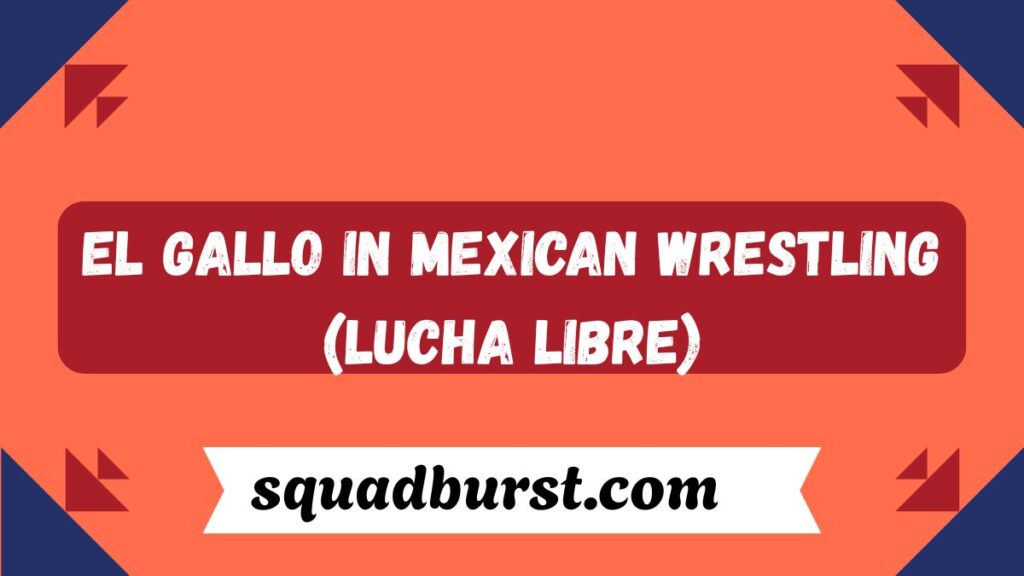
Mascot and Symbol of Fighters
Lucha Libre embraces rooster symbolism through character names, masks, and storylines. Wrestlers adopt names like “El Gallo Negro” (The Black Rooster) to evoke images of fierce combativeness and unwavering determination.
Lucha Libre rooster characters embody the fighting spirit associated with these birds. Their personas typically feature aggressive wrestling styles combined with colorful, rooster-inspired costumes. These characters resonate with audiences who understand rooster symbolism.
Wrestling promoters recognize that rooster imagery instantly communicates strength, pride, and fighting ability to Mexican audiences. This understanding shapes character development and marketing strategies within the lucha libre industry.
Rooster metaphors in professional wrestling extend beyond Mexico. International wrestling promotions sometimes feature rooster-inspired characters when targeting Latino audiences. This global recognition demonstrates the universal appeal of rooster symbolism.
Iconography in Lucha Libre
Rooster iconography appears on masks, costumes, and promotional materials throughout the lucha libre world. Artists incorporate rooster feathers, combs, and spurs into wrestler designs. These visual elements immediately identify characters with rooster-like qualities.
Wrestling masks featuring rooster designs become collector’s items among fans. The artistic quality of these masks often rivals fine art, with intricate details that capture the essence of rooster pride and aggression.
Mexican wrestling merchandise frequently incorporates rooster symbols. T-shirts, posters, and action figures feature rooster imagery that appeals to fans who understand the cultural significance behind these symbols.
Championship belts sometimes feature rooster motifs when held by wrestlers with rooster personas. These design elements add authenticity to character presentations while honoring Mexican cultural traditions.
“El Gallo” as a Metaphor
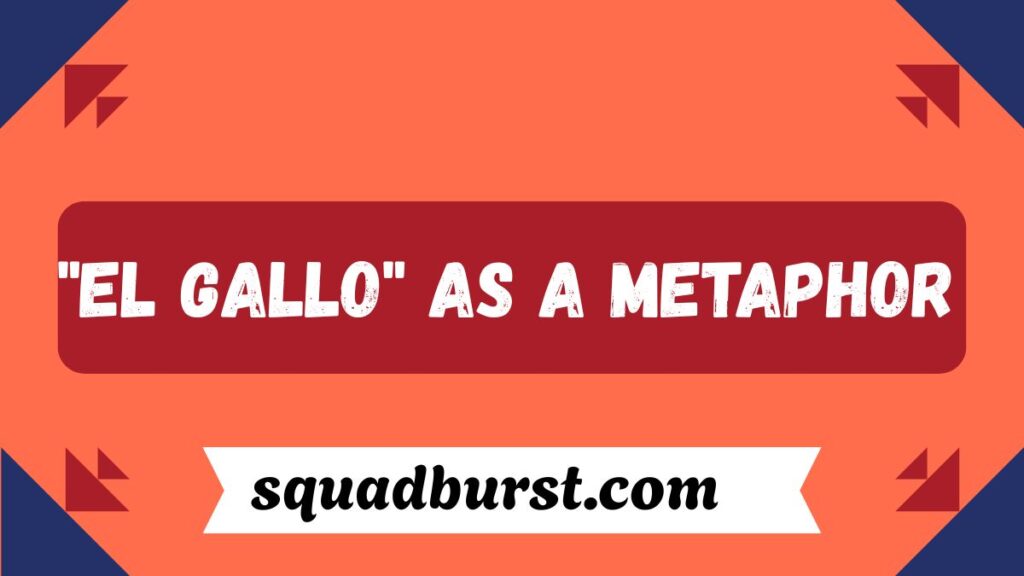
The Rooster as a Fighter
Rooster metaphors in fighting contexts draw from centuries of cockfighting traditions. While modern sensibilities question this practice, the linguistic legacy persists in expressions like “gallo de pelea” (fighting rooster) to describe determined individuals.
The rooster’s natural tendency to fight when threatened makes it a perfect metaphor for human resilience. People facing difficult challenges often describe themselves as fighting “como un gallo” – with determination and courage.
Confidence and swagger associated with roosters translate into human behavioral descriptions. Someone walking with “paso de gallo” moves with proud confidence. This metaphorical language enriches Spanish expression.
Combativeness doesn’t always carry negative connotations when associated with roosters. Sometimes it represents necessary strength for protecting family, defending principles, or overcoming obstacles.
Popular Phrases and Idioms Involving “El Gallo”
Spanish proverbs featuring roosters offer wisdom about life, relationships, and personal conduct. “Gallito de casa, sabe hasta donde puede llegar” teaches about knowing one’s limitations while maintaining confidence.
“Más vale ser gallo en pueblo chico que pluma en pueblo grande” suggests it’s better to be important in a small community than insignificant in a large one. This saying reflects rooster pride and the importance of finding one’s proper place.
Mexican proverbs about roosters often address competition and rivalry. “Dos gallos no cantan en el mismo gallinero” warns that two leaders rarely coexist peacefully in the same space.
Regional variations of rooster expressions exist throughout Spanish-speaking countries. These linguistic differences demonstrate how rooster symbolism adapts to local cultures while maintaining core meanings.
El Gallo in Religion and Spirituality
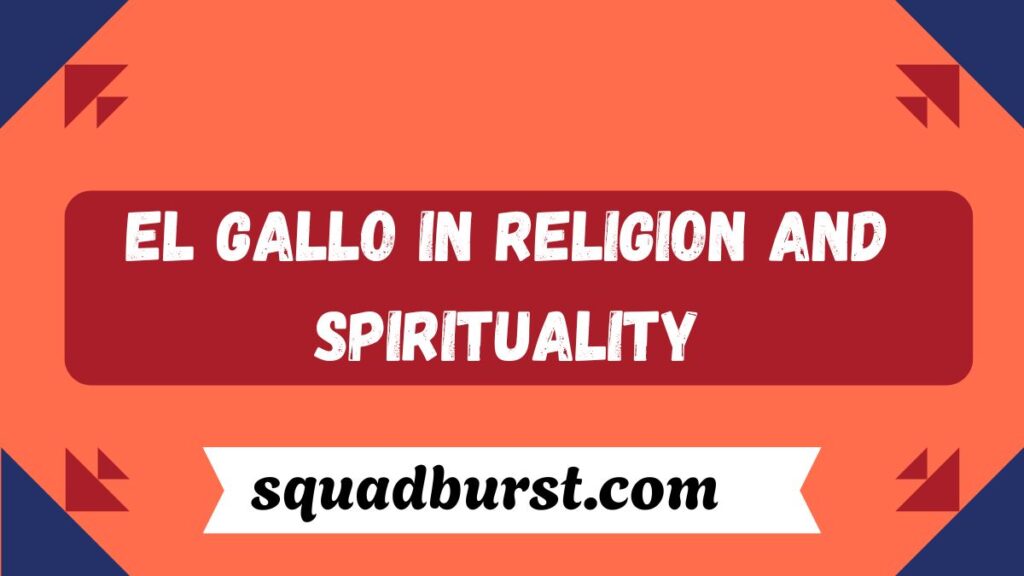
The Rooster in Catholic Iconography
Catholic symbolism incorporates roosters primarily through the story of Peter’s denial of Christ. The rooster’s crow reminded Peter of Jesus’s prophecy, leading to repentance and spiritual awakening. This narrative makes roosters symbols of redemption and moral conscience.
Religious symbolism extends beyond biblical narratives. Catholic churches in Latin America sometimes feature rooster imagery in artwork and architecture. These representations remind believers about vigilance and faithfulness.
Spiritual protection associations with roosters appear in various Catholic traditions. Some believers view roosters as guardians against evil spirits, particularly during nighttime hours. This belief stems from roosters’ natural alertness and protective instincts.
Divine watchfulness connects to rooster behavior patterns. Their ability to sense approaching dawn represents spiritual sensitivity to divine presence. This symbolism appears in religious art and literature.
Spiritual Significance of El Gallo
Spiritual awakening symbolism makes roosters important in meditation and contemplative practices. The rooster’s crow at dawn represents the moment when spiritual seekers achieve enlightenment or deeper understanding.
Rooster spiritual meaning varies across different traditions. Some view them as symbols of solar energy and masculine divine power. Others see them as reminders of temporal existence and the importance of seizing each day.
Spiritual illumination connects to roosters’ association with dawn and light. Spiritual practitioners sometimes use rooster imagery in visualization exercises focused on overcoming darkness or ignorance.
Shamanic traditions occasionally incorporate rooster symbolism for protection and courage. These practices recognize roosters’ natural alertness and their role as flock guardians.
The Role of “El Gallo” in Festivals and Traditions
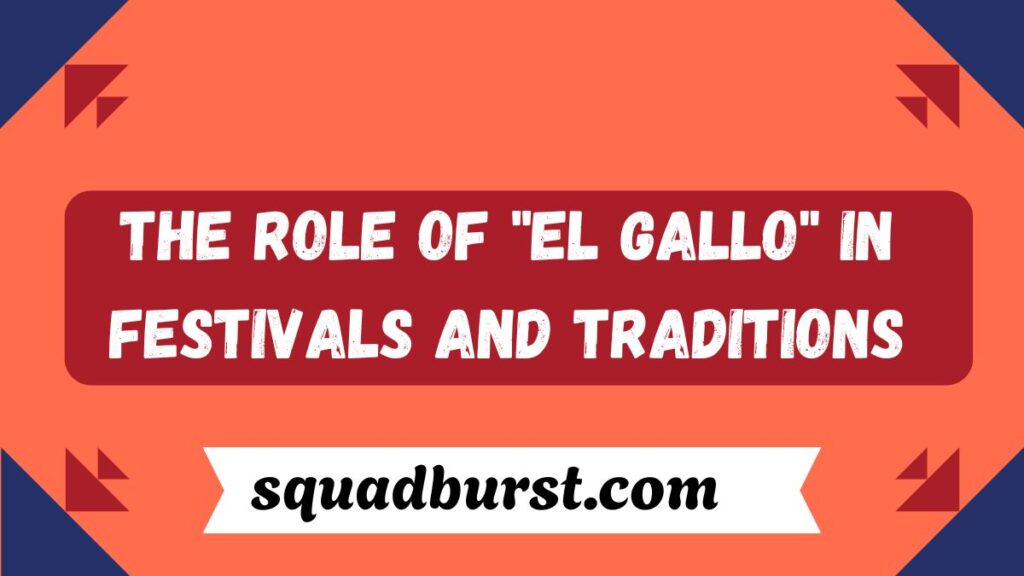
Festivals Honoring the Rooster
Rooster festivals in Mexico celebrate both agricultural heritage and cultural identity. These events typically feature rooster-themed food competitions, music performances, and traditional dancing. Communities use these festivals to strengthen social bonds.
Día del Gallo celebrations occur in various Mexican communities, though dates vary by region. These festivals often coincide with harvest seasons or religious observances. Activities include rooster calling contests and traditional craft demonstrations.
Annual rooster festivals sometimes incorporate educational elements about agricultural history and animal husbandry. These components help urban populations understand rural traditions and their continued relevance.
Traditional celebrations featuring roosters often include storytelling sessions where elders share folklore and wisdom. These oral traditions preserve cultural knowledge for younger generations.
Rooster Symbolism in Cultural Celebrations
Cultural celebrations across Latin America incorporate rooster imagery in decorations, costumes, and performances. These visual elements immediately communicate themes of pride, courage, and renewal to participants.
Wedding ceremonies occasionally feature rooster symbolism to represent the groom’s commitment to protecting and providing for his new family. This tradition connects modern marriages to ancient protective symbolism.
Mexican festivals celebrating patron saints sometimes include rooster elements in processions and ceremonial displays. These religious celebrations blend Catholic traditions with indigenous cultural practices.
Community harvest festivals frequently honor roosters for their role in agricultural life. These celebrations recognize both practical and symbolic contributions of roosters to farming communities.
Global Perspectives on “El Gallo”

Rooster symbolism extends far beyond Latin American cultures. The Gallic rooster serves as an unofficial symbol of France, representing national pride and revolutionary spirit. This adoption demonstrates roosters’ universal appeal as symbols of courage and determination.
Chinese zodiac traditions assign specific personality traits to people born in rooster years. These individuals supposedly possess confidence, honesty, and leadership abilities. The Year of the Rooster occurs every twelve years in the Chinese calendar.
Rooster of Barcelos Portugal tells the legend of a dead rooster that crowed to prove an innocent man’s truthfulness. This Portuguese tale reinforces roosters’ association with justice and divine intervention.
Ancient civilizations including Greeks and Romans revered roosters for their connection to sun gods and dawn deities. These historical associations influenced later Christian and Islamic symbolism involving roosters.
Rooster symbolism in Christianity
Rooster symbolism in Christianity extends beyond Peter’s denial story. Early Christians sometimes used roosters as symbols of resurrection and triumph over death. Church weathervanes often feature roosters to symbolize spiritual vigilance.
Global cultures continue discovering new meanings in rooster symbolism. Modern interpretations might emphasize environmental stewardship, sustainable agriculture, or cultural diversity while maintaining traditional themes of strength and renewal.
The enduring appeal of El Gallo across cultures and centuries testifies to the power of symbolic thinking in human societies. Whether appearing in ancient mythology or modern popular culture, roosters continue representing fundamental human values like courage, protection, and hope for new beginnings.
This magnificent bird’s journey from barnyard to cultural icon demonstrates how meaning of El Gallo in Spanish culture transcends simple translation. El Gallo embodies the complex relationship between humans and nature, tradition and modernity, individual pride and community values.
As we move further into 2025, El Gallo remains relevant in discussions about cultural identity, environmental awareness, and authentic living. The rooster’s morning crow still calls us to wake up, take notice, and embrace each day with courage and determination.
Understanding El Gallo’s rich cultural significance helps us appreciate the depth and beauty of symbolic traditions that continue shaping human experience worldwide. This knowledge connects us to centuries of wisdom while inspiring us to create meaningful traditions for future generations.
Conclusion
El Gallo: A Cultural Icon with Rich Meaning and Significance in 2025 continues inspiring people across generations and borders. This powerful symbol connects us to our ancestral heritage while embracing modern interpretations. From Vicente Fernández‘s passionate ballads to traditional Gallo en Mole recipes, the rooster’s influence touches every aspect of Latin culture. Its message of courage, renewal, and protection remains as relevant today as it was centuries ago.
The enduring appeal of El Gallo: A Cultural Icon with Rich Meaning and Significance in 2025 proves that authentic symbols never lose their power. Whether you encounter roosters in Lucha Libre arenas, Mexican festivals, or spiritual practices, their significance transcends simple farm animals. El Gallo reminds us to face each dawn with strength, embrace our cultural identity, and protect what matters most. This magnificent bird will continue crowing its message of hope and determination for generations to come.
FAQs
What does El Gallo mean in Mexican culture?
El Gallo means “the rooster” and symbolizes strength, courage, and masculine pride in Mexican culture. It represents protection, dawn, and new beginnings across Latin American traditions.
Who sang the famous song “El Gallo de Oro”?
Vicente Fernández, known as the “King of Ranchera,” popularized “El Gallo de Oro” in the 1970s. This classic song celebrates the fighting spirit and triumph of a golden rooster.
What is Gallo en Mole in Mexican cuisine?
Gallo en Mole is a traditional Mexican dish featuring rooster meat cooked in rich, complex mole sauce. It’s served at important celebrations and family gatherings throughout Mexico.
How is El Gallo used in Lucha Libre wrestling?
Wrestlers adopt rooster-themed names like “El Gallo Negro” and wear rooster-inspired masks and costumes. The rooster represents fighting spirit and fierce determination in Mexican wrestling.
What religious significance does El Gallo have?
In Catholic tradition, the rooster symbolizes spiritual awakening and moral conscience, referencing Peter’s denial of Christ. It represents redemption, vigilance, and divine watchfulness in Christian iconography.

Emma Grace is a creative contributor to Squad Burst, blending her love for fashion and sports into captivating content. Her fresh perspective and relatable voice make her a favorite among readers who share her passion for style and athleticism.
